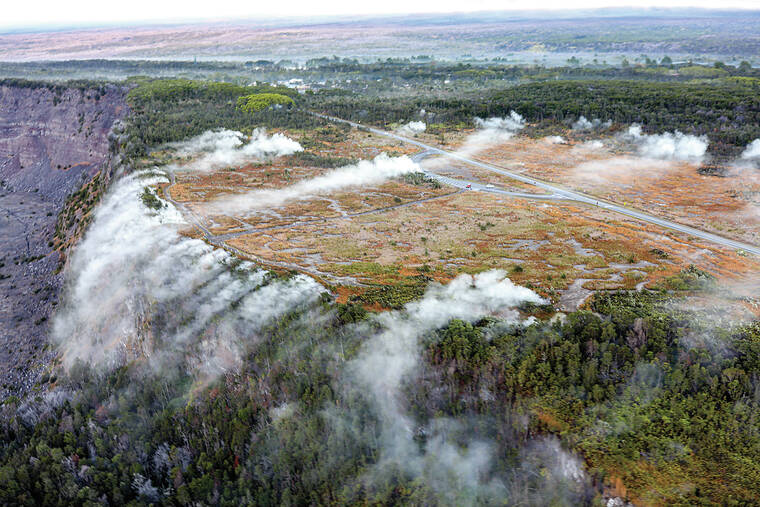For the ‘Olelo Hawai‘i version of this article, please see http://tinyurl.com/34day2pr.
February is Mahina ‘Olelo Hawai‘i, Hawaiian Language Month, and an opportunity to appreciate the value that the Native Hawaiian language has provided to volcanology, especially here in Hawai‘i nei.
The ‘Olelo Hawai‘i alphabet consists of twelve letters, along with two diacritical marks that indicate pronunciation. The ‘okina (glottal stop) appears like a backwards apostrophe and is treated like a consonant, while kahako (macrons) appear as a line over vowels, indicating a long vowel pronunciation. Both ‘Olelo Hawai‘i and English are the official languages of the State of Hawaii.
Native Hawaiians were the first observers of volcanic activity in Hawai‘i and used words for geologic features that science communities continue to apply today. Volcanologists around the world use pahoehoe, ‘a‘a, and kipuka, for example. Pahoehoe and ‘a‘a are the two main types of basaltic lava flows. Pahoehoe has a smooth, sometimes ropy texture whereas ‘a‘a is rough and broken. Kipuka color the lava flow landscape like patchwork. They are pockets of vegetation surrounded by younger lava flows, illustrating one definition of kipuka as “a variation or change in form.”
Numerous newspapers of the 1800s written by Native speakers, and published in ‘Olelo Hawai‘i, provide us valuable insight to eruptions and their effects, while ‘Olelo Hawai‘i place names help us understand landscapes and their use. Keanakako‘i, for example, is a small crater near the summit caldera of Kilauea. Its name means “the cave in which azdes were made,” providing us with an understanding of the place (a crater) and how the location was used in the past (adze source).
Native Hawaiian oral traditions also inform volcanologists of the range of behaviors at Hawai‘i’s active volcanoes. For example, when a water lake appeared at the bottom of Halema‘uma‘u following the 2018 caldera collapse, Hawaiian chants provided clues that surface water had been found at the summit in earlier times. Likewise, the saga of Pele and Hi‘iaka is thought to record extensive lava flows, as well as an earlier collapse of Kilauea summit caldera, in about the year 1500.
Native Hawaiians today continue to call the elemental force creating the ‘aina (land) Pelehonuamea (Pele of the red earth), while molten lava is pele (no longer used with English additions such as “Madame, Goddess, or Deity”). ‘Olelo no‘eau (Hawaiian sayings and proverbs compiled and interpreted by Mary Kawena Pukui) pertaining to Pelehonuamea describe her relationship with landscapes and people living on them, particularly in the District of Puna. “Ka wahine ‘ai la‘au o Puna” translates to the “tree-eating woman of Puna.” “Po‘ele ka ‘aina o Puna,” tells us that “The land of Puna is blackened [by lava flows].” These sayings convey a sense of geologic history of destructive lava flows from Kilauea in Puna.
Over the years, spellings of ‘Olelo Hawai‘i words and place names have evolved, to better reflect their pronunciation, meaning, or grammar. For example, the Hawaii Board on Geographic Names provides guidance to the U.S. Board on Geographic Names (USBGN), which standardizes the spellings names of places, features, and areas within the United States. They recently corrected the spelling of lava shield features on the Southwest Rift Zone and East Rift Zone of Kilauea. Maunaiki and Maunaulu, both of which used to be two words (Mauna Iki and Mauna Ulu), are now one to better align with ‘Olelo Hawai‘i rules, grammar, and usage.
The names of some locations have also changed over time. Using details found on archival maps of the early 19th century, the name of Kilauea caldera, the site of frequent eruptions over the past 200 years, was recently updated in the USBGN database to be Kaluapele, meaning “the pit of Pele.” The seamount formerly named Lo‘ihi (because of its length) was updated based on Native Hawaiian cultural knowledge, including chants, to Kama‘ehuakanaloa — “the ruddy, reddish child of Kanaloa,” the elemental force whose kuleana (responsibility) includes the ocean.
The USGS Hawaiian Volcano Observatory looks forward to future opportunities to incorporate ‘Olelo Hawai‘i vocabulary, and deeply appreciates valuable observations of volcanic activity made by Native Hawaiians.
Volcano
activity updates
Kilauea is not erupting. Its USGS Volcano Alert level is ADVISORY.
Disbursed seismicity at Kilauea’s summit and along the Koa‘e fault system southwest of the caldera continues following an intrusion of magma into the area that occurred Jan. 31-Feb. 1, 2024; on average, earthquake counts remain below 10 per day. Tiltmeters near Sand Hill and Uekahuna bluff have recorded little change over the past week, both show mild inflationary trends. Periods of increased earthquake activity and rates of ground deformation can be expected to continue in this region. No unusual activity has been noted along the rift zones.
Mauna Loa is not erupting. Its USGS Volcano Alert Level is at NORMAL.
Webcams show no signs of activity on Mauna Loa. Summit seismicity has remained at low levels over the past month. Ground deformation indicates continuing slow inflation as magma replenishes the reservoir system following the 2022 eruption. SO2 emission rates are at background levels.
Two earthquakes were reported felt in the Hawaiian Islands during the past week: a M3.1 earthquake 22 km (13 mi) S of Fern Forest at 40 km (24 mi) depth on Feb. 18 at 12:18 p.m. HST and a M2.8 earthquake 3 km (1 mi) SSW of Pahala at 33 km (20 mi) depth on Feb. 17 at 11:36 a.m. HST.
HVO continues to closely monitor Kilauea and Mauna Loa.



